Jewel of India
Bhagavad GITA
The largest-selling edition of the Gita in the Western world, Bhagavad-gita As-It-Is is more than a book. It is alive with knowledge and devotion; thus it has the power to change your life for the better.
Quick Facts
The Bhagavad-Gita is the main source-book on yoga and a concise summary of India’s Vedic wisdom.
90+
languages it is available in
700+
pages organised in 18 chapters
26+
million copies sold worldwide
50+
Years in pulication
Inside Look
Few Illustrations In the Book

Bhagavad-gita 4.1
Krsna teaches the science of Bhagavad-gita to Vivasvan, the sun-god. Vivasvan later teaches his son, Manu, and then Manu teaches his son Iksvaku.
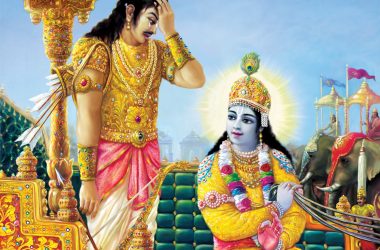
Bhagavad-gita 1.26-29
Arjuna laments upon seeing his relatives standing opposed to him in battle. Krsna, smiling, is ready to console His friend by His transcendental teachings.
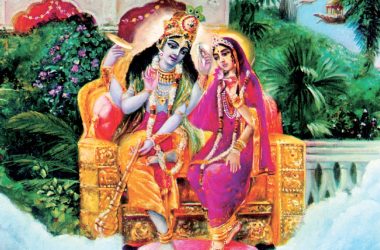
Bhagavad-gita 7.15-16
Laksmi-Narayana are shown in the Lord's transcendental abode.
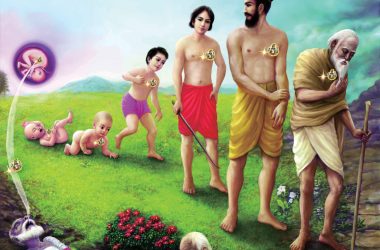
Bhagavad-gita 2.13
The spirit soul is seen changing bodies from childhood to youth to old age to death and then into the womb of another mother.
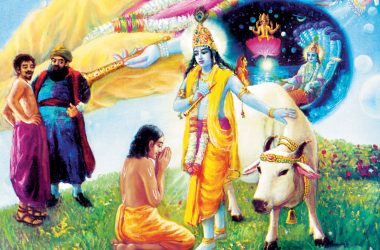
Bhagavad-gita 9.11
The fools mock the humanlike form of Lord Krsna, but the devotee offers his obeisances. Behind Krsna are Maha-Visnu, Garbhodakasayi Visnu and the entire cosmic manifestation-all working under Krsna's direction.

Bhagavad-gita 11.13
Krsna's universal form is displayed to Arjuna. Still the Lord does not loose His original eternal identy,. He remains seated on the chariot with Arjuna.
About Us
We are a team of volunteers from Greater Toronto Area (GTA).
Freebhagavadgita.ca is our small endeavour to share the fascinating eastern philosophy, the greatest treasure for mankind, a gift from ancient Vedic times yet very much relevant and applicable for all ages.
Our Approach
Words fall short to express our gratitude to all those great saints, heroes and well-wishers who carefully protected this priceless treasure and passing on from generation to generation to bestow this profound wisdom that makes perfect sense.
- Mutual Respect
- Simple Living High Thinking
- Sharing is Caring
- Community Service
About ISKCON
a.k.a the Hare Krishna Movement
ISKCON includes five hundred major centers, temples and rural communities, nearly one hundred affiliated vegetarian restaurants, thousands of namahattas or local meeting groups, a wide variety of community projects, and millions of congregational members worldwide.
Worldwide
ISKCON has expanded widely since its founding by His Divine Grace A. C. Bhaktivedanta Swami Prabhupāda in New York City in 1966.
Ancient
ISKCON belongs to the Gaudiya-Vaishnava sampradāya, a monotheistic tradition within the Vedic or Hindu culture.
Books
The historic texts of the devotional bhakti yoga tradition, which teaches that the ultimate goal for all living beings is to reawaken their love for God.
About Book
Bhagavad-Gita is the essence of all the Vedic (ancient) knowledge and is one of the most important Upanishads in Vedic Literature.
Bhagavad-Gita is a classic of timeless wisdom, the summum bonum of spiritual truth. It has deeply influenced the thinking of generation of philosophers, theologians, educators, scientists and authors all over the world.
Bhagavad-Gita originally appears in the form of 700 Sanskrit versions, as an episode of the Mahabharata, a great historical epic.
- To deliver mankind from Ignorance
- Every man is in difficulty in so many ways, as Arjuna was in difficulty in having to fight the battle of Kurukshetra. Arjuna, forgetful of his prescribed duties as a kshatriya(warrior), whose duty is to fight for a righteous cause in a holy war.
- Lord Krishna, who agreed to act as the driver of Arjuna chariot see his friend and devotee in illusion and perplexity. He than proceeds to enlighten Arjuna regarding his immediate social duty as a warrior and more important, his eternal duty or nature (Sanatana-dharma) as a spirit soul.
- To revive the eternal relationship of love between each soul and God
- Krishna speaks for the benefits of all souls, who have forgotten their eternal nature and eternal relationship of love with him. To revive this relationship is the ultimate goal of our existence.
- This question has legged fellows offers from time in memorial and since man is a “thinking animal” he is not simply satisfied by trying to fulfill his basic needs. He asked many questions about his surroundings, his planet, his universe and about the mystery of his own existence – the mystery of who am I?
- Modern science deal with this vital question in vary mechanic manner, stating that man is nothing but a combination of certain material elements, the smallest part of which are atoms or electrons, which constitute the origin of life.
- But, am I simply a bunch of atoms? Is this really life? Thankfully some thoughtful scientists are not so convinced. Noble laureate Albert Szent-Gyorgyi commented, “In my search for life I ended up with atoms and electrons which have no life at all, and somewhere along the line, life has run out through my fingers.”
- And then, what is ‘death’? The law defines death as the “absence of life” but no clear understanding exists today on the exact nature of life. How, then, would one define life? Life is simply distinguished by certain symptoms and hence both “life” and “death” remain great puzzles.
- To understand this let us start with a simple illustration of a play which is being watched by 2 entities,
- a man (living being)
- a camera (non living being)
- But still there is a distinct difference between the observers. So what is the difference between the man and the camera? It is consciousness in other words Life Is Consciousness.
- The activities of eating, sleeping, mating and defending are common in animals and human beings. The human beings are considered superior only when they inquire about the Absolute Truth, otherwise they are considered as good as animal.
- By understanding the Bhagavad-Gita, it is possible to understand the relationship between the GOD and the SOUL. This is called ‘Sambandha’.
- Process of reviving the soul’s relationship with God, this is called Abhidheya.
- To make a permanent solution to the suffering in this world.
The Bhagavad-Gita essentially deals with the following five topics.
- Eswara (God)
- Jiva (Spirit-Soul)
- Prakriti (Material nature)
- Kala (Time)
- Karma (Activity)
- Modern science has absolutely no understanding of the first two of the five subjects of Bhagavad-Gita (Isvara and Jiva) and very limited and imperfect understanding of the last three subjects (Prakriti, Kala and Karma).
- This is because the very process of acquiring knowledge that it follows is defective. It is called the ascending or inductive process (aroha-pantha).
- The inductive or ascending process means to not accept any authority and to try to find out the truth by one’s own endeavor and speculation.
- As opposed to the inductive or ascending process, is the deductive or descending process (Avaroha-Pantha).
- The deductive or the descending process means to accept a bona fide authority and learn the truth by inquiring from that authority.
- The inductive process is always fraught with uncertainty and inaccuracy.
- Scriptures like the Bhagavad-Gita are the perfect authority from which we can acquired knowledge, because they are the word of God. This is the simple and straightforward method to obtain true knowledge.
- The word of GOD
- The law book of life
- A manual for the universe
- Absolute knowledge
- Perfect Science
Consciousness means the awareness of being “who I am”.
There are seven good reasons to indicate the source of consciousness is distinct from the body.
- Who sees and hears?
- When I say, “I see” or “I hear”, who is it that is actually seeing or hearing? Is it my eye that sees? Or my ear that hears? A dead body has eyes and ears but it does not see or hear. Why?
Is the perception of sight or hearing, in the brain or the nervous system of the body then? But a dead body has a brain and nervous system too, yet it does not see or hear. Why? - The answer is that, the perceiving is being done by something or someone distinct from the body
- When I say, “I see” or “I hear”, who is it that is actually seeing or hearing? Is it my eye that sees? Or my ear that hears? A dead body has eyes and ears but it does not see or hear. Why?
- Put back chemicals in a dead body and make it alive!
- If chemicals are indeed the source of life or consciousness as the scientists say, then one can simply put the chemicals back in a dead body and make it alive again!
But this cannot be done because life does not come from matter but from some other source. Scientists have never been able to show or prove their claim by making dead things come to life.
It is our unfailing, common experience that life comes only from life and not from dead matter or chemicals.
- If chemicals are indeed the source of life or consciousness as the scientists say, then one can simply put the chemicals back in a dead body and make it alive again!
- Common-sense understanding
- When a person dies, the relatives lament, “oh! He has passed away”.
But, who has passed away? The person they love is still lying there.
The body has not gone anywhere. So who has gone away?
Obviously, something which is different from the body and which made the body appear ‘alive’ has gone away.
- When a person dies, the relatives lament, “oh! He has passed away”.
- Intuitive understanding
- We say, “My hand, “My body”, and so on, not “I hand”, or “I body”, meaning thereby that my hand, body etc., are different from ‘me’ the owner of these things.
So who is that ‘me or ‘I’ who owns this body and who drives it?
- We say, “My hand, “My body”, and so on, not “I hand”, or “I body”, meaning thereby that my hand, body etc., are different from ‘me’ the owner of these things.
- Body changes but “l’ remains the same
- At every moment from conception in the womb till death, our body is constantly changing. In his book, “The Human Brain”, Prof. John Pfeiffer notes that, “Your body does not contain a single one of the molecules that it contained seven years ago… That means every seven years our whole body changes. Yet, our sense of identity, or “I” ness remains.
In other words the source of “I’ ness or consciousness, does not change with changes in the body. Therefore, it must be something different from and superior to the body.
- At every moment from conception in the womb till death, our body is constantly changing. In his book, “The Human Brain”, Prof. John Pfeiffer notes that, “Your body does not contain a single one of the molecules that it contained seven years ago… That means every seven years our whole body changes. Yet, our sense of identity, or “I” ness remains.
- 6&7. Out-of-Body Experiences (OBE) Near-Death-Experiences (NDE)
- Evidence that the source of consciousness must be distinct from the body is also supported by research on Near-Death-Experiences (NDE).
Sometimes, people on the verge of death have reported having extraordinary and baffling experiences that defy modern scientific understanding.
NDE includes out of body experiences (OBE) in which people report observing their physical body and events relating to it from a point outside of the body during severe illness or physical trauma resulting into unconsciousness.
Soul is the source of consciousness.
In the Bhagavad Gita Lord Krishna explained that the source of the consciousness is the spirit soul the ‘Atma’ which is eternal and spiritual. We have seen about seven good reasons to believe that the source of consciousness is distinct from the body.
Three level of existence:- the gross body
- the subtle body, and
- soul
The gross body is, in ordinary terms, our physical body comprising earth (solid element), water (liquid element), fire (heat element), air (gas element) and ether (space element). Earth is the grossest element and ether is the most subtle. The subtle body comprises mind, intelligence and false ego. These three elements cannot be directly perceived by any of our senses although they can be experienced.- The mind is the storehouse of desires and memories
- Intelligence is the faculty of discrimination
- False ego, the subtlest of all brings the eternal soul under illusion and makes it identify itself with the temporary material body.
- The soul, of course, being non- None material is superior to all the about eight elements is beyond the two bodies and is proprietor of both bodies.
- Evidence that the source of consciousness must be distinct from the body is also supported by research on Near-Death-Experiences (NDE).
According to the law of karma for every action that is an individual perform there is an appropriate reaction this is a subtle law that governs all the activity of living beings.
There is a similar law in modern science “Every action has an equal and opposite reaction”.
The law of karma is a law of cause-and-effect or action and reaction. This means that for everything we do there will be a reaction, and for everything that is happening there is a past cause (known or unknown).
Three types or Karma
- Karma
- Vikarma
- Akarma
The word ‘Yoga’ comes from the Sanskrit word ‘Yuj’ which means ‘to reunite or link’. It is a link of love and service. The Lord and the soul are eternally and constitutionally linked in a bond of love. To re-establish that link, is yoga.
‘Dharma’ means that which cannot be separated from something.
- What is it that cannot be separated from fire? Heat and light.
- From sugar? Sweetness.
Thus the ‘dharma’ of fire and sugar are heat and sweetness respectively.
Similarly, the ‘Dharma’ of the living being is to serve.
We all have an innate tendency to love and serve. But presently that propensity is being directed towards the people and things of this world. Therefore, it simply ends in frustration.
Only when we repose our loving and serving propensity in the Supreme Lord, Sri Krishna, can we find real fulfillment and happiness.
This is ‘Sanätana-dharma’, or the eternal function of the soul.
Famous Personalities
What Do They Say

Aldous Huxley
The English writer found Gita “the most systematic statement of spiritual evolution of endowing value to mankind.” He also felt, Gita is “one of the most clear and comprehensive summaries of perennial philosophy ever revealed; hence its enduring value is subject not only to India but to all of humanity”.

J. Robert Oppenheimer
American physicist and director of the Manhattan Project, learned Sanskrit in 1933 and read the Bhagavad Gita in the original form, citing it later as one of the most influential books to shape his philosophy of life.
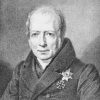
Wilhelm von Humboldt
Wilhelm von Humboldt pronounced the Gita as: “The most beautiful, perhaps the only true philosophical song existing in any known tongue... perhaps the deepest and loftiest thing the world has to show.”
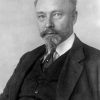
Hermann Graf Keyserling
German Philosopher regarded Bhagavad-Gita as “Perhaps the most beautiful work of the literature of the world.”

Lord Warren Hastings
Lord Warren Hastings, the first governor general of British India wrote: “I hesitate not to pronounce the Gita a performance of great originality, of sublimity of conception, reasoning and diction almost unequalled; and a single exception, amongst all the known religions of mankind.”
Request Yours for Free
FAQs
Frequently Asked Questions
As soon as we receive a request for new Book, it becomes our priority to make sure we deliver it timely. A team member may get in touch with you soon to discuss further.
Generally No, however there may be cases where we might have a nearby contact office outside Canada to where we can forward your request for fulfilment. A team member will work with you in this case.
Yes, its absolutely free, and no-strings attached. However, sometimes we may run out of copies that may cause delay or temporary halt in our endeavour to distribute free books. We will let you know whatever the case may be.
Please feel free to write to us anytime at info@freebhagavadgita.ca if you want to leave a message for us or have any questions.